The Chinese fascination with young boys, particularly those of the de-testiculated sub-genus, has been well-documented by scholars for centuries. Throughout history, eunuchs have been a source of fear as well as a subversive power structure hidden in the shadows of the Dragon Throne. As one would expect for such a mysterious force, they have long inspired the creation of various action figures and snack foods.
In the one hundred and thirty-fifth Ox year (622 by Western reckoning), the emperor La Yu ruled over the Middle Kingdom. He was a dedicated fan of eunuchs, and a connaisseur of all things smooth and hairless. Such were his appetities that on certain weekends, he would gather the entire court and…I digress. From his great love of the form sprang an order to the imperial kitchens: “Create a tribute to eunuchs – one that will ensure they are never forgotten. Make it in their image, and make it…tasty.”
Well, that’s how gyoza were invented. The chefs were in a quirky mood, and rather than form a tribute to the remaining portion of the eunuchs, they modeled their creation on the subtracted portion. I’m sure they would have been as surprised as anyone to learn the longevity of their creation, and they would certainly have been shocked, in a nationalistic and indignant way, to learn that the apotheosis of the associated art was achieved sometime in the Showa period in a cluttered alley behind Kameido Station.
But there’s no denying it.
The sun was shining and I had no particular place to go until nightfall, so I rode my bike up to Kameido and freestyled around for an hour pretending that I was looking for an interesting place for lunch when I knew, had I been honest with myself, that I was going to eat gyoza, if only I could remember where the heck the shop was with no map and just a few hazy memories from 5 years earlier when I visited one time. Eventually I saw a configuration of signs and streets that made something go off in my head, and after a quick trip to the hospital to treat the aneurism I went back to that place and quickly found Kameido Gyoza, right where I left it.
The first thing you’ll see when you come in is a big wooden tray of gyoza. They go through these with frightening rapidity. It doesn’t bother me that they’re made off-site; at the famous place I’ve been to in Ueno, they make them out in the alley, under the train tracks. I can’t think that’s especially sanitary, but you know I don’t mind so much about the sanitation.
‘Frightening rapidity’ is actually the chef’s name, which is Chinese for ‘Sir Cooxalot’. He just stands there plundering the gyoza trays, dipping the individual dumplings (dare I say it…sacs?) in oil, and throwing them in the pans.
You may or may not be shown to a spot at the counter (there’s also a koagari, or raised tatami-matted seating area). I stood around for a little while thinking it was full before one of the waitresses yelled that I should sit anywhere. It’s that kinda place – rough, but with a heart of gold. Here’s what you’ll see from the far end of the counter, mercifully away from the frying pans. The retro posters are a nice touch, but I was surprised to see they’ve redone the ‘menu’, such as it is, by replacing the old sign boards on the walls with identical new ones.
Don’t bother ordering. After a little while a waitress will drop off a saucer, then smear a glob of mustard on the side. Mixing your preferred combination of soy, vinegar and chili for dipping purposes is strictly up to you. And shortly after that, your first place of gyoza will arrive. Please note in advance that they come 5 to a plate, with a strict 2-plate minimum. On my first visit, they were quite aggressive about making sure you understood the minimum and also got through the first two plates rapidly. This time, it was almost laid back.
It would be fun to try doing a Metropolis / Japan Times-y review one of these days, but I don’t want to obscure the fact that these gyoza are great, nor damn them with faint and flatulatory prose. Oops. They’re right on – not too meaty, not too garlicy, fried really brown and crusty on one side. I wonder if it makes a difference that they don’t cover the pans; I think that’s unusual, technique-wise, but it certainly pays dividends.
Helpfully, the sign on the wall lists the price for a (500ml) bottle of beer and various numbers of plates of dumplings. I always chuckle when I see these signs because there’s never a quantity discount. 12 plates? That’ll be one plate’s price, times 12, plus beer.
18 plates? Gotcha covered right here. I saw a sign once in Shibuya that went up to 50 plates, but that was a long time ago and I bet some of the people who were there that night are dead already. Imamura san, the host, died with his suit on while out for his morning constitutional. I think he would have been happy that he went out in style after a lifetime of running a metalworking factory.
What’s that you say, more gratuitous shots of gyoza facing extermination?
Sure.
People can pretty damn enthusiastic about eating these gyoza. Look at the pile of empties in front of the big, sweaty guy next to me. That’s right, you’re lookin’ at 8 big ones, also known as 40 sacs. The only thing better than this was the ancient couple across from me – they ate 7 plates. EACH.
My meager total is bashfully hiding its head on the right. I figured with only a small beer (not the size on the price chart. I wonder how they managed to calculate my total!) and 30 minutes solid bike ride each way from home, this wasn’t too bad. And seeing as it wasn’t too bad, it was damn good!
Damn!
03-3681-8854
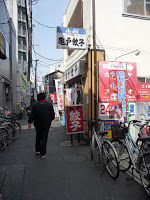
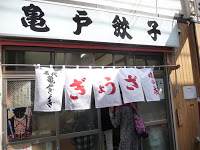
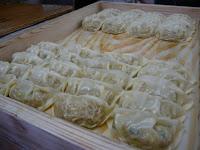
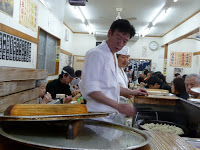
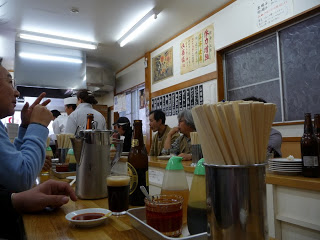
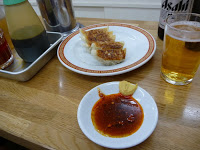
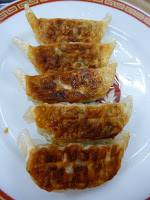
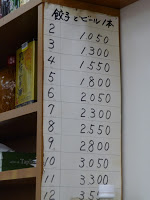
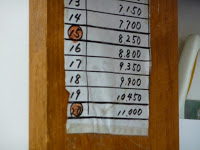
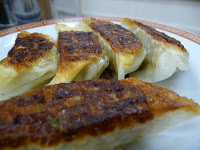
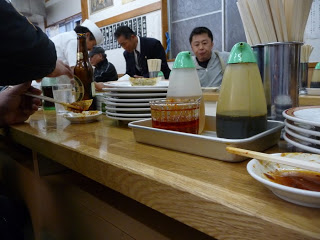
Jon – You basically described my perfect day although I will never be able to eat these things without some part of my sub-conscience pondering my masculinity. Looking forward to our next culinary adventure with you.
– Peacock (Male version)
Smooth and hairless? Gather the entire court and…?
In any case, I am here, and eating every day. Bring it on.